CSR Policy
- We will provide customers (customers, regions, etc.) with products and services that contribute to building a resource-recycling oriented society.
- We will reduce environmental burdens and risks in our business activities.
- The management and employees will together participate in environmental conservation activities.
- We will promote business activities considering biodiversity.
Priority Measure
Managment of Suspended or Abandoned Mines and
Conservation of the Aquatic Environment
While the DOWA Group has its roots in the mining and smelting business, we have currently stopped business operations at all the nonferrous metals mines that we own in Japan. For such mines, in order to protect the environment of the surrounding area, it is necessary to maintain and improve pollution prevention even after the operations have stopped, such as disasters happening from cave-ins or landslides, or preventing environmental pollution due to waste and wastewater.
Management of Suspended or Abandoned Mines
As for suspended or abandoned mines, while this refers to mines where operations have been suspended or the mining rights have lapsed, administrators regularly do walk-around checks of the mines and disposal facilities. It is necessary to continue managing them in order to prevent mine pollution and harm to third parties. Unekura Mining Co., Ltd., which was founded in 1956, has two offices located in Odate, Akita Prefecture and Misaki, Okayama Prefecture, and manages over 20 suspended or abandoned mines from Hokkaido to Shimane, including wastewater treatment.
Their business includes a wide range of activities, such as management of the mining sites, maintaining and managing storage sites and facilities where slag is piled up, managing the water quality of mine wastewater and monitoring the water quality of the surrounding area. The company strives to protect the environment and prevent disasters on a daily basis. Particularly for mines where nonferrous metals have been mined, even after operations are suspended or stopped, such treatment is especially important because there is the possibility that the mine wastewater will continue to contain heavy metals and such.
Preventing mine pollution is something that happens while dealing with nature. This maintenance requires specialized skills and knowledge as facilities at the mines can be damaged due to impact from the weather, such as rainfall and snowfall, and fluctuations in the amount of treated water and the quality of the water. In addition, during tours of inspection, sometimes there are encounters with pit vipers, Japanese serows and bears on forest trails, requiring quick judgment and reactions.
In order to reduce the burden of such maintenance, currently the major treatment facilities are remotely monitored, and we are aiming to improve the efficiency of operations with automatic recording of the monitoring status, and the incorporation of a system that automatically reports when there is abnormal turbidity or a power outage.
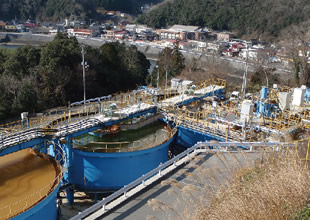
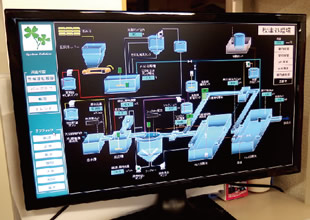
Initiatives to Conserve the Aquatic Environment
At nonferrous metal mines that have been closed, part of the ore remaining in the mine may come in contact with groundwater or the oxygen in the air, causing an oxidation reaction to occur, and water that contains acidic water or heavy metals could flow out. In addition, with the mined ore, there is the risk of water quality or agricultural land becoming polluted as wastewater seeps into rivers with harmful heavy metals due to rainwater or groundwater from storage sites where things with low metal content have been discarded. The treatment of mine wastewater is important and indispensible in order to maintain sound water circulation and a sustainable environment for water use.
The mine wastewater cannot be discharged into rivers unless the pH, heavy metal content and suspended solids content are below the standard for drainage water. As the main treatment method, we utilize a method of doing alkali neutralization with lime, and then releasing into rivers the water from which the heavy metals have been removed.
Among the water resources used for processing in the entire DOWA Group, the largest amount is “sea water“ that is used as cooling water, but the input amount for “mine wastewater” is the next largest, and we are carrying out processing 24 hours a day 365 days a year.
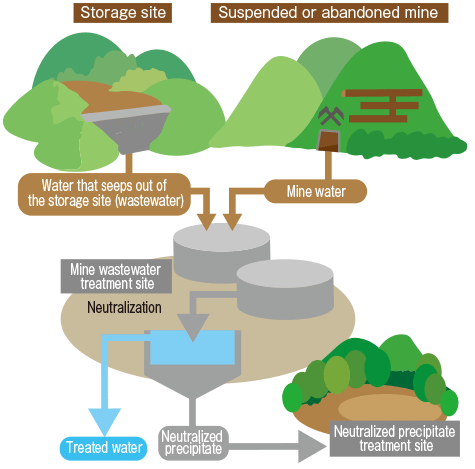
Unekura Mining Wastewater Treatment Technology
The treatment of mine wastewater at suspended or abandoned mines needs to be continued semi-permanently, and an efficient processing method that is low cost and has little environmental impact is required. At Unekura Mining, the company is working to improve the mine wastewater treatment process by introducing various technologies, such as passive treatment that utilizes natural purification, processing that uses thermal spring wastewater and the neutralization method with iron oxidizing bacteria.
Treatment Facilities Without Electricity
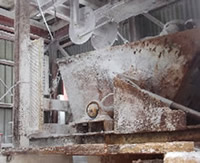
Some mining facilities do not have power transmission lines, and some treatment sites do not have electric power facilities. For this reason, we introduced self-oscillating equipment in which lime is input according to the amount of water so that treatment can be carried out without using electric power, and efficient neutralization treatment can be done. The self-oscillating equipment was developed in-house using the principle of “shishi-odoshi” (a bamboo tube that when filled with water revolves to empty). It contributes to energy savings and lower costs.
The Recycling of Neutralized Percipitate
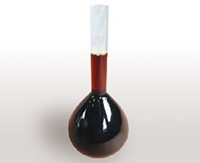
The “neutralized precipitate” that occurs from the treatment of mine wastewater is mainly composed of gypsum and iron hydroxide. While it is waste if left as is, through processing it is used as a deodorizer. In addition, by effectively using the iron that is in the mine wastewater, we produce and recycle inorganic flocculant “polyferric sulfate” (product name: Bioferric). Bioferric is used In sewage treatment plants and helps with waste reduction and the conservation of the aquatic environment.





![Environment[環境]](../img/field/bg_focus_environment.jpg)